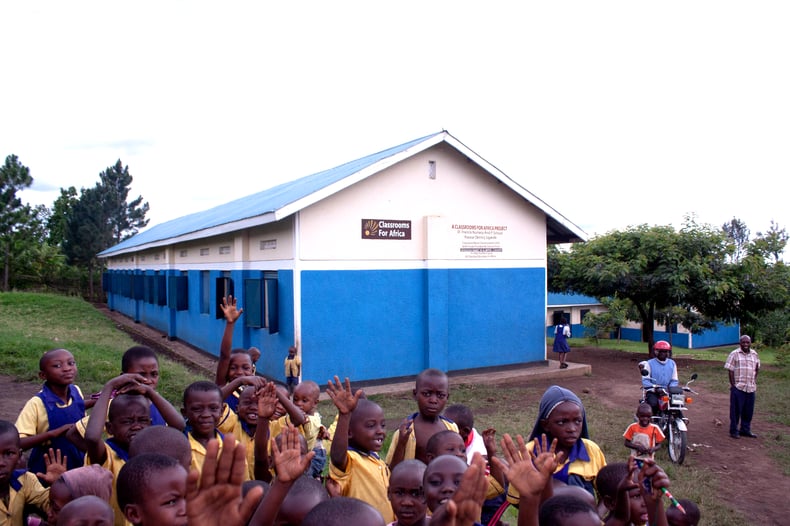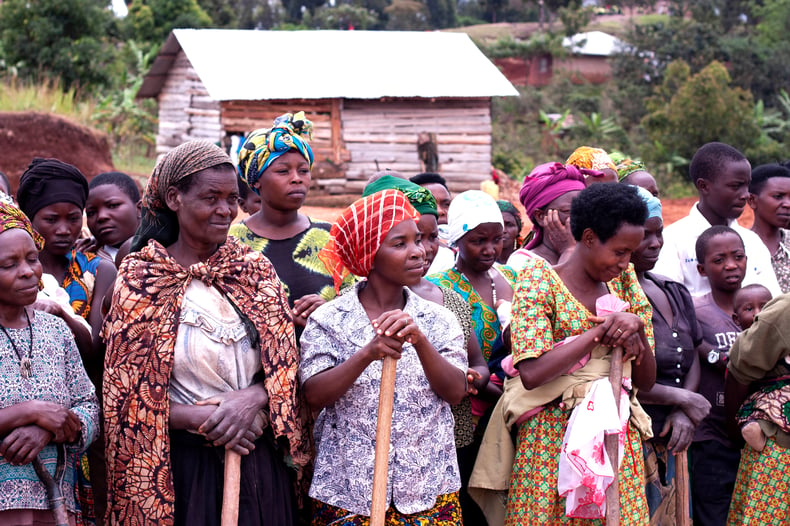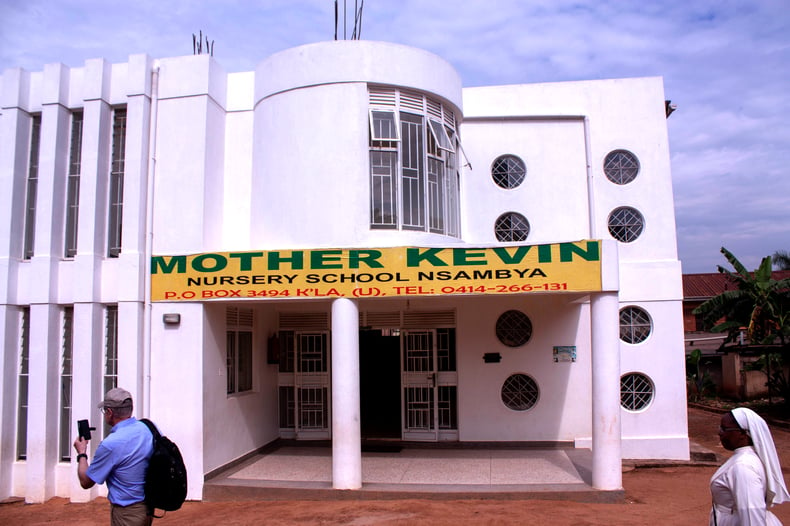
Overview
In 2019 Jambo joined the Pledge 1% global movement with the commitment to give 1% of profits to Classrooms for Africa, a Canadian charitable initiative that helps communities build classrooms in disadvantaged areas of Sub-Saharan Africa
Giving Tuesday falls on the first Tuesday in December and is an important global movement that encourages organizations to give-back through volunteer hours or donations to support any cause of their choosing. In the spirit of this #GivingTuesday, Jambo’s Customer Success Lead, Kristen Badley, has written the following guest blog about her recent trip to Uganda with Classrooms for Africa. Here, Kristen describes the impact Classrooms for Africa is having on local communities, students and their families.
Thank you for reading!
________________________
“Ok, I have a story to tell you. There are four boys. These four boys are standing on a hill looking across at another hill. The boys see 20 trees on the other hill. The boys are four and the trees are twenty. How many trees did each boy see?”
The teacher smiles and we chuckle—Robert has set the kids up: he has been asking the children about division up to now, implying this is a division problem. The kids seem to agree the answer is five. Robert smiles as he waves goodbye, telling the kids their teacher will explain the joke.
I grin at Robert, “that was tricky.”
He laughs, “yes, I suppose asking them about division first made it a bit tricky.”
Over the next week, I will hear Robert pose this question to several different kids. Some catch on to the trick, while others assume it’s a math problem. Sometimes he explains the joke, other times he leaves it for the teacher. He asks me once why I don’t give the answer. “It gives the students a chance to show us what they know and then have a laugh,” I explain.
.jpg?width=790&name=Day%204%20(7%20of%20149).jpg)
We step out of the classroom and look out over the rolling hills of Uganda. We’re up above the city of Kasese and the view goes on for miles. I am here on an eight-day trip with Classrooms for Africa, a Canadian charity that provides funds to communities in Sub-Saharan Africa who have taken on the challenge of providing education for disadvantaged children.
Along with four other donors, I will be visiting school projects across Uganda funded by the organization. For me, my Ugandan adventure started much earlier than this week. In fact, it started two years earlier with one simple word: “Hello,” or as the locals say, “Jambo.”
Jambo has a double meaning for me. It is both a Swahili greeting, offered as a welcome to another person and the name of the software company I work for.
Jambo is a web application designed to help teams organize and manage their stakeholder relationships and easily track their engagement and consultation with these stakeholders. We named the software Jambo because all consultation starts with “hello” but also, because we knew we wanted to continue giving back to communities in Africa where we could make a big impact. This year, to make our promise to give back official we joined Pledge 1%.
Pledge 1% is a global movement of organizations committed to giving back 1% of their profit, time, equity or product to deserving sources. For Jambo, we have pledged 1% of our profits to Classrooms for Africa. Through this connection, I am here on behalf of Jambo to see, firsthand, the impact we can make, and that is how I have come to be here in Kasese on this humid day in November.
.jpg)
But, before I get too far ahead, let me introduce myself: my name is Kristen and I am the Customer Success Lead for Jambo. On this trip with me is Silvacom President and CEO Tom Grabowski and his wife Marilyn, as well as Classrooms for Africa board member Don Dick and his wife Gail. In-country, we connect with Robert, who works for Classrooms for Africa as a Project Manager. Over the next eight days, we will visit projects throughout the country, meet people impacted directly, and explore a country that is well-deserving of the name, the “Pearl of Africa.”
Classrooms for Africa operates differently than a lot of other charitable organizations. The other donors and I aren’t going to Africa to build physical classrooms. The local communities don’t need us to come to their villages and lay bricks or mix cement as they already have skilled labourers within their communities ready and available to do the work. They don’t need us to ship them supplies from Canada as they have products and methods that suit their climate much better on hand. What they do need from us is support through charitable donations to pay for the labour and to buy the materials they can’t make by hand.
Classrooms for Africa provides communities with donations in a secure and well-managed way. They gradually provide the funds as the project progresses, paying for each stage as the previous one is completed. The organization also ensures there is project management on-site, making sure the projects are completed on-time and on-budget.

This process ensures the success rate of completed projects is incredibly high and donated funds are used effectively and efficiently (95 cents from each dollar goes directly to the school projects!). Classrooms for Africa also vet each new project before taking it on, ensuring that the community in question fully supports the school before one brick is ever laid.
The schools that our team will visit fall loosely into three categories:
- Established schools that no longer need support from the organization
- Active projects that have some finished buildings but could still use some work
- Proposed projects where work has not started and may not be approved
Most of the projects we visit fall into the second category with at least one classroom building having been completed, though the schools still need more work and support. Some schools still need dormitories, while others need kitchens. It’s all part of meeting each school’s most urgent needs.
At some schools, the old traditional classroom blocks still stand and are still in use (nothing is wasted here). These buildings are mainly made of sticks woven in between wooden slats and then covered in mud. They are often roofed in thatch and the floors are just dirt, which means everything is quickly turned to mud during the rainy season.
The new classroom buildings funded by Classrooms for Africa are generally made from earth bricks that the schools make themselves and fire on site. Then buildings are plastered using locally sourced materials and sealed. The rooms inside are impressively spacious and cool despite the heat with lots of natural light from well-placed windows. The walls are often covered in homemade vocabulary posters and the student’s artwork.
.jpg)
One school that stands out for me is Matere Model School. This is the school in the hills above Kasese where Robert made me laugh and where our story began. This school is an outcropping perched on the tip of a mountain. The views go on for miles and show an agricultural community very much isolated from their neighbours. The surrounding mountains act as walls making travel difficult. The school is not yet finished, with scaffolding still erected around the walls and the outer coat still to be applied, but they have made an excellent start. I can’t help but think how difficult it must be to get supplies like the iron sheeting for the roof up the steep drive as it’s largely isolated. The school is located up a dirt road that is almost impassable in the rain and we must hike the last bit on foot through the mud to get there.
.jpg)
When we arrive, the kids welcome us with songs and dances and the local community is excited to see us. At the end of the welcoming ceremony, the schoolmaster says: “Prepare your drums, we are coming!” The ceremony stays with me and reminds me that today is an important day for this community. Today is a celebration of their achievements, of their hope for the future and of their partnership with the Classrooms for Africa donors. It is a fun day for the whole community. We watch the drums and the dancing for a bit as they celebrate together, but as time is limited, we must move on to see the buildings.
The kids here are curious about us. They follow us from room to room. While walking, I am convinced I will trip over them, but they stay just out of reach. They watch everything we do with curiosity. Finally, I kneel down to be at their level, and I smile and wave. They want to touch me, to know what my skin is like, but we don’t share a language and while they are curious, they are also shy. When I reach out so they can give me a high five many hands reach back at once and soon it is a circle of giggles and laughter.

Later, on the way back down the mountain, we briefly stop at St. John’s High School where the local community is out clearing space for another classroom block development. The clearing is being done with hand tools and it looks like a lot of work. The whole community is out helping. It isn’t easy to take days off work to clear a patch of ground, but despite the poverty in the community, they want to make sure the school is built. This community cares about their kids and they want the best for them, especially a good education. They want opportunities for them that they never had, and this desire is universal as they remind me a lot of my mom and dad looking out for my future.
While seeing schools that are currently in progress makes the most sense to me, it takes me longer to realize why we are visiting completed school projects that no longer need our help. Tom explains to me that we are their partners in education. Our partnership does not end with the completion of a school. We are here to maintain that relationship with them and to show our continued belief in their work and the importance of what they do. It is also a relief to see some of these schools. To see happy kids dancing, others still in class. To see well-cared-for rooms that have allowed schools to expand. To see schools that, while they could still grow, are meeting the needs of their communities.

Mother Kevin Nursery School is a completed school project located near the Nsambya slum in the Ugandan capital of Kampala. Originally, it educated kids from the orphanage nearby but has expanded to include more neighbourhood kids. Here, the young kids are having fun dancing along to music played over the speakers. We investigate the classrooms where colourful signs hang everywhere. There is so much light in these rooms. We move up to the second level and see more airy rooms and well-built washrooms. What makes me happiest though is the smiling kids. Everyone seems so happy, and I don’t think they are just excited to have visitors.
.jpg?width=790&name=Day%206%20(3%20of%205).jpg)
Beyond the schools that are almost complete or are not fully established, there is the Star Nursery and Primary School that has not yet started but already has an interesting story. The headmistress, Mary Nakato, donated her family land to build the school. The site already has one block of classrooms, a nursery block and a kitchen. There is a second classroom block that is just posts and slats and a church that is built the same way. Along one side of the field is the foundation of another block where the overgrown grass shows the signs of an abandoned construction project where funds have run-out.
The school has space here but has obviously reached the limit of what they can do without help. We are careful to not make promises that we can’t keep, but I hope the project can be funded by donations in the future. It becomes clear to me that there is still so much need in this country.
.jpg)
All in all, we visit 10 schools, seven of which have already received donations from Classrooms for Africa donors. Between those seven schools, Classrooms for Africa has impacted the lives of 3,200 students, this year alone. Tom tells me that Classrooms for Africa estimate to date that there are 300 projects completed or currently under development. That’s a lot of impacted students!
Epilogue
I have one last story to tell you. We are standing on a hill and we look across the valley to the other hill. On the other hill are 800 students, 12 teachers, all their families and friends, the people who they will save as doctors and nurses, the kids they will impact as teachers, and the multitude of others they will impact in the other roles they will take on in the future. How many classrooms do we each see?
Like Robert’s question, this one is also a trick, but the answer isn’t simple. It might be none, it might be one, and it might be enough for all of them. I am looking forward to the time when this isn’t a trick question anymore.





